Kimberly Nicholas's Blog, page 4
December 1, 2022
When life + climate are out of tune 🌷 +🍁= 😬
Hi friends, welcome back to We Can Fix It, where we tackle the climate crisis with facts, feelings, and action, written by me, climate scientist Kim Nicholas. Here goes:
Facts: Climate denial still in style 🧟♂️The playbook for climate denial is so classic that a grad student writing a course paper in 2004 (me!) identified arguments and approaches still used today.
Climate denial is, unfortunately, having “a bit of a renaissance,” as Amy Westervelt writes in Drilled. Reading her piece on industry lobbyists framing regulation as economically harmful, and working to “undermine the science that regulation is based on,” and a piece by Emily Atkin and Michael Thomas in HEATED about fossil-funded NGOs working to “dismiss the dangers of warming” and “shift public opinion to reject mainstream climate science” reminded me of tactics I identified in my old paper. Join me, won’t you, for a little stroll down Climate Memory Lane for these vintage gems!
Key climate denial strategiesIdentified from my 2004 course paper analyzing US-based climate change “skeptics” (who often referred to themselves as “realists”), including market-based think tanks and industry groups. Any of these strategies sound familiar? :/
Undermine mainstream, consensus science, which agrees that it’s warming, it’s us, we’re sure, it’s bad, we can fix it:Deniers try to establish their own scientific credibility and legitimacy, and claim they are “objective,” “impartial” and “nonpartisan”
Emphasise uncertainty, disagreement, and “confusion” within the scientific community
Critical of the definitive Big Bad Mothership of Climate Facts, the IPCC
“Dismiss the dangers of warming” (as Atkin and Thomas put it):I wrote that skeptics “portrayed the possible results of climate change as largely benign, or at least within the range of adaptation.”
Here’s an eye-popping example, given the extensive climate harms the world is experiencing today:
Advocate delay through research
“The mild global warming now projected by computer models that the environmentalists say we should believe would simply return us to the best weather in history… Farmers would get milder winters, fewer storms, only a slight increase in daytime summer temperatures and more carbon dioxide to fertilize crops and pastures…”
—Dennis T. Avery, writing for the Cooler Heads Coalition in 1998
Claim that no action should be taken until further research reduces uncertainty.
In the year 2000, The Marshall Institute recommended “at least 25 years of research on the issue before CO2 emission cuts need to be considered”… They’re coming pretty close to their wish. :( [Ed. note: Substack doesn’t seem to allow subscripts, that non-subscript 2 is driving me crazy, sorry!]
Use economic arguments to support delayI found that skeptic groups “represent the economic impacts of regulation of greenhouse gases or other mitigation efforts as widely distributed, high cost, causing extensive job loss, regressive, limiting consumer choice, particularly harmful to certain struggling industries, and an ineffective use of resources given scientific uncertainty.” The following quote illustrates a typical argument about claimed economic infeasibility:
“No advanced nation or group from such a nation has a right to sanctimoniously demand that people from developing nations forgo their hopes for a better standard of living…No nation is willing to pay the political price for the economic devastation that will occur if it seriously suppresses its energy use.”
-William O’Keefe, President of the think tank George C. Marshall Institute, in 2002. Reprinted in The New York Times, where it’s still online!
Sooooo frustrating to see these same debunked myths still wandering the climate streets, zombie-like. At least now there’s lots of research to understand and document climate obstruction; the Climate Social Science Network (of which I’m a member) is a good place to start.
Feelings: Asynchrony 🌷 +🍁= 😬This fall was weird. It was too warm. I wore a T-shirt to rake maple leaves when I should have been bundled up in a sweater.
Here in Lund it was still “meteorological summer” well into November, because it hadn’t been officially chilly enough to signal the start of fall. And that warm weather led to a “second spring,” with plants that should be dormant “bursting back to life,” as The Guardian put it.
Normally the sight of flowers blooming and plants sending out new buds in our garden brings me joy, but for the first time this fall, seeing new flowers brought me a sense of unsettled dread.
I felt in my bones that life and the climate were getting out of synch. I’ve named this disturbing sense of being out of tune with nature’s calendar “asynchrony”.
 This bean plant should have been long dead. November 12, 2022. Photo: Simon Rose
This bean plant should have been long dead. November 12, 2022. Photo: Simon Rose I worried for the trees and bushes that were spending their depleted energy sending out hopeful shoots, which were killed by the first frost a few days later.
It felt wrong to see this new life so late in the year, because I knew these plants were supposed to be long since dead (annuals) or slumbering for the winter (perennials), to rebuild their energy for next spring.
Winter is time for rest. Living beings need rest to renew our bodies and spirits. Climate change is cutting away our season of rest.
Action: Support climate lawsuits 👩🏽⚖️The climate action that’s energizing me most right now:
636 young people suing the Swedish state, arguing Sweden’s insufficient climate policies threaten their human rights.Aurora, the group leading this work, has been building their case for two years. These folks have done their homework— looking at what strategies have worked elsewhere, and mapping out their paths to regional, national, and international courts.
I consider this Sweden’s best chance to bring climate action closer to what science says is necessary right now— and a promising strategy for all over the world.
My colleague Mark Connaughton was in Stockholm to observe the march delivering the documents to court last week:
@auroramalet as they sue the Swedish state for insufficient climate policies. I was there as an observer for the GAMES project at @LUCSUS_LU which is studying links between science, law and activism. https://t.co/1D8VUTui03 ","username":"ConnaughtonMar","name":"Mark Connaughton","date":"Fri Nov 25 13:06:49 +0000 2022","photos":[{"img_url":"https://pbs.substack.com/media/FiaWHV... Mark Connaughton @ConnaughtonMarInspiring to join the young and old demonstrating in Stockholm in support of @auroramalet as they sue the Swedish state for insufficient climate policies. I was there as an observer for the GAMES project at @LUCSUS_LU which is studying links between science, law and activism. https://t.co/1D8VUTui03
Mark Connaughton @ConnaughtonMarInspiring to join the young and old demonstrating in Stockholm in support of @auroramalet as they sue the Swedish state for insufficient climate policies. I was there as an observer for the GAMES project at @LUCSUS_LU which is studying links between science, law and activism. https://t.co/1D8VUTui03 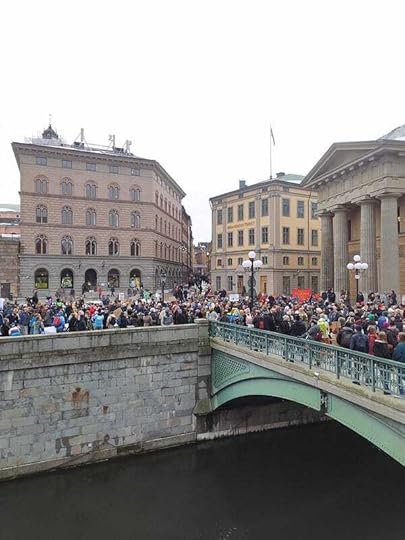 1:06 PM ∙ Nov 25, 202221Likes3Retweets
1:06 PM ∙ Nov 25, 202221Likes3RetweetsSimilar cases have been successful in The Netherlands, Germany, and Ireland— resulting in court orders for countries to revise their climate action plans to reduce emissions faster.
One key feature of these cases is that they are rights-based. Rather than seeking damages from harm, they argue insufficient climate mitigation violates fundamental human rights enshrined in documents like national constitutions or international treaties.
The rights-based approach isn’t common yet. A study by Annalisa Savaresi and Joana Setzer found only about 6% of legal climate cases so far (112 out of 1841) use a rights-based approach. But rights-based cases have been rapidly increasing since 2017, and are found on every continent, especially in Europe.
So here’s your action: Donate your cold, hard cash to support holding governments accountable in court for taking the climate action they’re responsible for.Click to donate to:
Aurora- young people suing the Swedish state (text in Swedish)
Our Children’s Trust- involved in cases globally, including in the US and Uganda
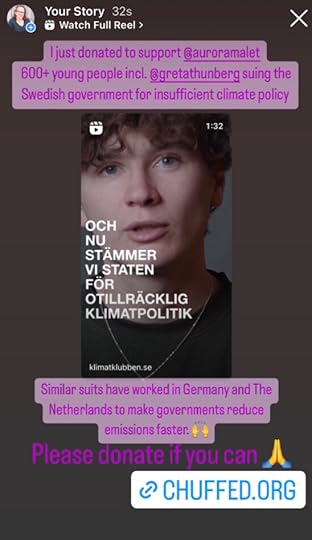 I donated to support Aurora, and you can too! Donate here (in Swedish).
I donated to support Aurora, and you can too! Donate here (in Swedish). These legal cases aren’t a silver bullet (because, spoiler alert, there is no single silver bullet to fix climate change!) Lawsuits are slow. Even if they’re won, the resulting climate plans still have to be implemented and enforced (which might require more lawsuits). Still, these cases are a major step forward, and an important strategy. Please support them!
PS. To dive deeper, check out this map of climate cases from the University of Zurich, and this snapshot of climate litigation trends from the Grantham Institute at Columbia Law School.
📚 2022 Climate Book Gift Guide 📚It’s holiday time— here are tips to make the holidays simpler and more meaningful.
And here’s my roundup of climate books I loved in 2022, paired with my suggestion for who on your gift list to give each book to. See the archive for my review.
The perfect climate book for:New parents: Parenting in a Changing Climate, by Elizabeth Bechard (Feb 2022)
Your friend who meditates: Zen and the Art of Saving the Planet, by Thich Nhat Hanh (March 2022)
Your outdoorsy BFF: Return to Nature, by Emma Loewe (April 2022)
Freaked-out millennials: Generation Dread, by Dr. Britt Wray (May 2022)
Foodies: To Boldly Grow: Finding Joy, Adventure, and Dinner in Your Own Backyard, by Tamar Haspel (July 2022)
Project managers: Climate Change Coaching: The Power of Connection to Create Climate Action, by Charly Cox and Sarah Flynn (August 2022)
That person who can’t put down their phone: How to Do Nothing: Resisting the Attention Economy, by Jenny Odell (September 2022)
Creatives: Dearly, by Margaret Atwood (October 2022)
 Of course, Under the Sky We Make also makes a great gift of climate action! :)See You On the Internet
Of course, Under the Sky We Make also makes a great gift of climate action! :)See You On the InternetI joined TEDxGlasgow for The Future We Choose - you can get a sneak peak of my 8 minute talk, including 1 minute of disastrous tech failure, here!
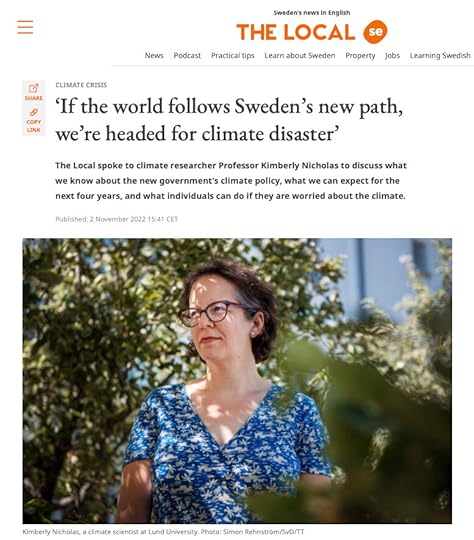 See you IRL?
See you IRL? I’ll be taking a mini-sabbatical at Stanford University at the start of 2023. Drop me a line if you’re in the Bay Area and want me to speak at your ESG meeting, book club, or basketweaving group!
Take care everyone, have a lovely holiday and I’ll see you back here in January!
xo,
Kim
Thanks for reading! Please share this post with a friend to spread climate action.
October 27, 2022
"Carbon neutral" is a bad goal
Hi friends, we’re back, tackling the climate crisis with facts, feelings, and action! I’m your fearless leader, Lund University climate scientist Kim Nicholas. Let’s dive in!
Facts: “Carbon Neutral” is a bad goalA recent study of first movers who are already “carbon neutral” showed that they mostly used magical accounting handwaving, not real emissions reductions, to get there.
At my department this week, Dr. Aaron Strong presented research on eleven American colleges and universities who achieved carbon neutrality by 2020.
Depressingly, Aaron and colleagues found that just 23% of total emissions reductions were “direct”— actually burning less fossil fuels on campus, replacing fossil-based with clean electricity, or reducing employee travel.
Most of this 23% came from the regional electricity grid getting cleaner over time (“Scope 2 reductions” in the chart below). Cleaner grids are good! But they’re a result of larger climate policy shifts, not university carbon neutral declarations. Womp womp!
The remaining 77% of the carbon counted towards institutional neutrality goals came from sketchy sources that may not truly reduce emissions. The paper goes into detail about why these approaches, like using bioenergy and relying heavily on voluntary carbon offsets, are problematic from both scientific and climate justice perspectives.
 Across 11 American universities reporting carbon neutrality, only 23% of emissions reductions came from burning less fossil fuels (largely from the electricity grid getting cleaner). The majority of reported reductions are from sketchy “accounting-based compliance” mechanisms. :( Source: Barron et al., 2021,
One Earth
. Red annotations and emojis added by Kimberly Nicholas.
Across 11 American universities reporting carbon neutrality, only 23% of emissions reductions came from burning less fossil fuels (largely from the electricity grid getting cleaner). The majority of reported reductions are from sketchy “accounting-based compliance” mechanisms. :( Source: Barron et al., 2021,
One Earth
. Red annotations and emojis added by Kimberly Nicholas.Aaron described the reliance on accounting, rather than real emissions reductions, as an example of “Goodhart’s law”— where decisionmakers optimise for the metric they’re given, not the intent behind that metric.
(Remember, to stop global warming, humans will have to completely stop adding carbon to the atmosphere, which requires virtually eliminating carbon pollution. Here’s a refresher on net zero and what it will take to stabilise the climate from We Can Fix It, May 2021).
Importantly, strategies pursued by carbon-neutral universities so far are not scalable. They do not match the investments and approaches needed to deliver a clean energy society.
For example, compared with the strategies needed to decarbonise the whole US, the universities have under-invested in energy efficiency by a factor of about 3, and in electrification by more than a factor of 10, while putting about twice the emphasis on biofuels. (See Figure 5 in the paper.)
Making climate goals meaningfulIn sum, given current rules and norms, making “carbon neutrality” the goal is likely to incentivise accounting tricks.
To accelerate the climate policy and market shifts needed, institutions should instead set a date (say, 2027!) to be “fossil free” for its own operations (Scope 1) and purchased electricity (Scope 2). This shift would make carbon neutrality a milestone achieved along the way to real decarbonisation.
Climate goals that leave fossil fuels in the ground are critical. Current initiatives focused on “neutrality” as the end goal, like the EU’s 100 Climate-Neutral Cities, risk following the path of the carbon-neutral university pioneers: pursuing offsets and other accounting schemes, instead of real reductions.
Feelings: Navigating “we” and “they”What does a fair response to the climate crisis look like? Who should do what?
Questions of fairness, responsibility, and justice are at the heart of motivating and directing climate action. They are central topics at the annual international climate negotiations starting soon (COP 27), where views… vary widely.
A recent essay beautifully illustrated varying perspectives on climate justice from different personal points of view. I want to share some of it with you here.
Subina Shrestha grew up in Nepal, where she learned “we [the Global South] must adapt because there is no other choice, and they [the Global North] must curb emissions because they are responsible for the problem.”
Now she’s pursuing a PhD in Norway, where discussions with her colleagues center around how “we” need to radically cut emissions, because “they” suffer the impacts.
Subina writes about her lived experience in navigating shifting aspirations and opportunities between “we” and “they”:
A month into my PhD, I began to realize that I was struggling to fit in because the discussions centered around how ‘we’ need to do more, cut down emissions radically because ‘they’ suffer the impacts. This reversal of ‘we’ and ‘they’ in my workplace left me stunned, to say the least, and I began questioning: in my current situation, which ‘we’ do I belong in?”
Most of my colleagues have travelled around the world, not just Europe. Their passports are inherently more powerful than mine… What is the basic standard for most of my colleagues is, in fact, a luxury for me…. I can’t help but ask if it is fair that they talk about radical lifestyle transformations, when we have always aspired to look upon their everyday?
-Subina Shrestha in Undisciplined Environments
What do you think? How do you relate to “we” and “they” when it comes to climate action?
Action: Eating as climate actionNow to combine two of my favorite things: eating tasty food + climate action!
We vote with our forks three times a day for the health of the living world, and our bodies.
Here’s some ways we can do better. It’s an excerpt from “Food Shouldn’t Come from a Factory,” the chapter in Under the Sky We Make where I confess that I’m a turkey heiress.
“Eat food. Not too much. Mostly plants.” -Michael PollanOkay, what does eating plants look like?
“Our research showed that plant-based diets were the highest-impact personal climate action when it comes to food.
A global analysis by the World Resources Institute found that a menu of twenty-two solutions was needed to achieve a sustainable food system; shifting to plant-based diets was the most effective.
The personal dietary change with the single biggest environmental benefit is cutting beef, which uses far more resources and produces far more pollution than other options.
Analyses have shown that we simply cannot meet even the 2°C goal without reducing today’s meat consumption.
If eating animals is part of a regenerative future, the livestock that remain will live on leftovers, not on food that people could eat. They are certain to be a much smaller part of a healthy and sustainable diet than what we eat in wealthier countries today.”
—Me in Under the Sky We Make
So glad you asked!
Right now, according to the EAT-Lancet analysis, the average American consumes:
Too much:Protein: twice as much as recommended for health
Red meat: six times higher than is healthy and sustainable
Egg and poultry: 2.5 times too high
Too little:fruits and vegetables (aim for twice as much; to cover half your plate)
legumes, like lentils and peas (aim for 5x more!)
nuts (also aim for 5x)
Aim for “Just right”: if you eat animal products, eat no more than:1 glass of milk, or 1 ounce of cheese per day (about the size of your thumb)
2 eggs per week
2 servings of chicken and fish per week (1 serving size = deck of playing cards)
2 beef burgers per month
Here’s what your average plate should look like:
 The “Planetary Health Plate”, representing a healthy and sustainable diet that could feed 10 billion people within planetary limits and with greatly improved global health. Source: EAT-Lancet, Harvard School of Public Health
The “Planetary Health Plate”, representing a healthy and sustainable diet that could feed 10 billion people within planetary limits and with greatly improved global health. Source: EAT-Lancet, Harvard School of Public Health For some inspo, Harvard public health folks have a sample meal plan that fits the planetary health diet:
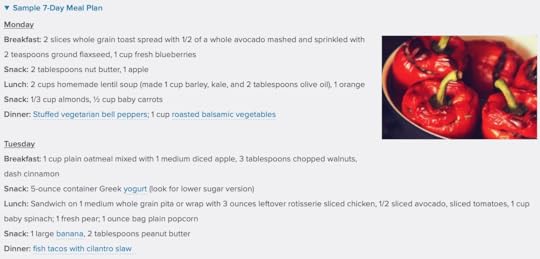 Sample meal plan for a week of Planetary Health Plate eating. Mmm, tacos. Source: Harvard T.H. Chan School of Public Health
Sample meal plan for a week of Planetary Health Plate eating. Mmm, tacos. Source: Harvard T.H. Chan School of Public Health Happy sustainable eating!
See you on the InternetHey, I’m joining TEDx Glasgow next week for “The Future We Choose”— sign up for your free ticket to this virtual gathering! It’s Tuesday, Nov 1 at 18:00 GMT. (That’s 11am in California, 2pm New York, 19:00 Sweden— gotta love the week where Europe has had daylight savings, and North America has not!)
 Book Recommendation
Book RecommendationDearly, by Margaret Atwood. This was the 1st time we’ve read poetry for my climate fiction book club, and I loved it. Reading a poem aloud is an amazing way to start a conversation. It really cut to the heart of things in a handful of words. “Faint Hopes” might be the best thing I’ve ever read about techno-optimism.
@MargaretAtwood today—the first poetry collection we've read as a group. Discussions of sorcerers, systems, and plastics abound! Some of my favorite lines ⬇️⬇️ ","username":"ludwig_bs","name":"Ludwig Bengtsson Sonesson","date":"Wed Oct 05 13:10:15 +0000 2022","photos":[{"img_url":"https://pbs.substack.com/media/FeTtn3... Ludwig Bengtsson Sonesson @ludwig_bsOur climate book club had the pleasure of reading Dearly by @MargaretAtwood today—the first poetry collection we've read as a group. Discussions of sorcerers, systems, and plastics abound! Some of my favorite lines ⬇️⬇️
Ludwig Bengtsson Sonesson @ludwig_bsOur climate book club had the pleasure of reading Dearly by @MargaretAtwood today—the first poetry collection we've read as a group. Discussions of sorcerers, systems, and plastics abound! Some of my favorite lines ⬇️⬇️ 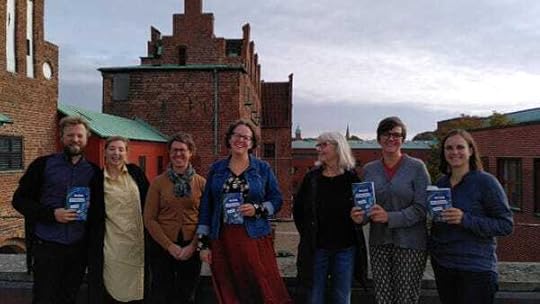 1:10 PM ∙ Oct 5, 2022
1:10 PM ∙ Oct 5, 2022Take care friends! Go for a walk and appreciate something seasonal today!
xo,
Kim
Thanks for reading! Please share the love, and this post!
September 29, 2022
Tough love from a climate scientist
Hi friends! It’s time to admit that, once again, many of my tomatoes are just not going to ripen here in Sweden. And to get on with the climate facts, feelings, and action!
Facts: Swedish political parties not listening to scienceI led a team of nine researchers in assessing the climate policies of the Swedish political parties ahead of our national elections held September 11, 2022.
We found that most parties are out of line with science in most areas we assessed. With the exception of the Green and Left Parties, most parties rely on tech solutions for more than they can deliver, avoiding necessary behaviour changes and failing to address root causes of the climate crisis.
If the world follows the path most of Sweden’s parties aim for (especially those coming into power now), we are headed for climate catastrophe. Womp-womp!
Overall, we grouped the political parties’ climate goals and plans into 3 categories:
Transformative: Greens, Left Party
Slow and Insufficient: Liberals, Centre, Social Democrats
Regressive: Christian Democrats, Sweden Democrats
 Overall party ranking. See next figure for a key to political party symbols. Source: Researchers’ Desk. Image by Emma Li Johansson.
Overall party ranking. See next figure for a key to political party symbols. Source: Researchers’ Desk. Image by Emma Li Johansson.Our assessment was based on responses to a survey sent to all 8 political parties. (The traditional conservative party, confusingly called the Moderates, did not answer.) The authors are all part of the nonprofit climate experts’ network Researchers’ Desk.
We assessed the parties in seven areas:
 Source: Researchers’ Desk. Image by Emma Li Johansson.
Source: Researchers’ Desk. Image by Emma Li Johansson.And analysed their main arguments, structure, and strategies:
 Source: Researchers’ Desk. Image: Noomi Egan.
Source: Researchers’ Desk. Image: Noomi Egan. This project started out of my frustration at the lack of scientific assessment of how political parties’ climate politics stack up with what research shows is needed for a fast and fair transition to a fossil-free world. While there are lots of analyses of the climate policies needed, voters generally cannot vote directly for a fossil fuel non-proliferation treaty, or for a legit climate pledge. Those are policies that only leaders in government have the power to enact.
What voters can do is vote for a specific party or candidate to represent them, and then hold those politicians accountable to deliver bold climate policies. Voting is the highest-impact climate action we can take as citizens.
We need evidence-based assessments both to guide voters, and to push politicians to improve their policies. To my knowledge, our Researchers’ Desk report is the first formal analysis by scientists of Swedish political parties’ climate politics.
We need more of these analyses around the world. I’ve heard from researchers who are interested in conducting similar assessments for their own national, regional, or local elections. Get in touch if you want advice!
I’m incredibly grateful to the amazing colleagues and friends who worked on this report: Maria Wolrath Söderberg, Jessika Luth Richter, Svetlana Gross, Erik Pihl, Åsa Kasimir, Wim Carton, Thomas Hahn, and Alasdair Skelton; and to the many people who helped us make this analysis happen and share our findings.
For more nerdy details on how we did the analysis, check out my Twitter thread. For news coverage (in Swedish), see the feature article in Dagens Nyheter and editorials from 9 Sept and 17 Sept; Sydsvenskan; Expressen; Omni.
Feelings: Tough love from a climate scientistI’m struggling with an uncomfortable climate feeling right now that I’m not sure what to do with. So I’ll put down a few words about it here, and see if anyone can relate!
Recently I’ve gotten a lot of questions about what to do about climate deniers. These questions inevitably come from people who are concerned or alarmed about climate change, who tell me they’re losing sleep thinking about their children’s future, and the people in Pakistan and Florida fleeing flooded homes, and dying forests and rivers.
The thing is, the other week, I hit a bit of a wall with fielding these questions.
Inevitably, the people asking me what to say to climate deniers are… to be blunt… really not taking much high-impact climate action themselves. They’re directing their energy fretting over what others are doing or not doing.
What I lose sleep over is not the tiny fraction (less than 10%) who are climate deniers. What keeps me up at night is the large majority of people who are climate concerned, but passive.
Data from the US show that 64% “rarely or never” discuss climate. In the past year, only 13% have donated money and 6% donated time to an organisation working on climate. Only 8% wrote or called a public official about global warming.
You are the people I’m trying to reach, because you are the ones who quite literally hold the fate of the world in your hands. And so far, too many of your hands are, well, not helping to “push the boulder of climate action,” as Katharine Hayhoe says.
 Many of you are freaking out about climate deniers, who are a small but vocal group. Meanwhile, I’M freaking out about YOU: the concerned majority, who are a large, powerful, but passive group. Stopping climate heating depends on YOU getting active.
Many of you are freaking out about climate deniers, who are a small but vocal group. Meanwhile, I’M freaking out about YOU: the concerned majority, who are a large, powerful, but passive group. Stopping climate heating depends on YOU getting active. Many hands make light work. Those of us pushing the boulder really need YOUR hands on it.
Everything is a lot right now. All of us need rest, breaks, play, nourishment. We need to take care of our own health and wellbeing, and to meet caring responsibilities to others. I’m not advocating running around like a headless chicken, or beating yourself up because you ate a burger.
But! Can you look in the mirror today and honestly say that you’re doing what is in your power to prevent climate breakdown?
You wail, “But what can I do?” You can flex your Top 5 Climate Superpowers— reducing your emissions as a consumer, and working for powerful change as a professional, with your investments of time and money, as a role model inspiring others, and as a citizen.
Where will you find the time? Well, the average American adult spends 11 hours a day consuming content: “listening to, watching, reading, or generally interacting with media.” Is all of this time actually informing, inspiring, or nourishing you?
Isn’t there 20 minutes a day you could spend on meaningful climate action? Getting the climate-concerned but passive majority to take 2 hours a week (6 days/week x 20 minutes; you get one day off to rest) of high-impact climate action would be utterly transformative.
What can you do with 20 minutes today? Well, did you ever actually call your elected official and demand climate action? (Here’s how.) Have you talked with at least one colleague at work about how your company can reduce flying? Are you a monthly donor to a climate charity like 350.org?
Go ahead and do your 20 climate minutes now, then come back. I’ll be here. <3
Action: How to save energy at homeOkay, so in Under the Sky We Make, I wrote that individual actions to save energy at home were not always the most effective way to go. And now I’m going to tell you how to save home energy. What gives?
Well, if you fly or drive, you will reduce your carbon footprint more by cutting those trips than by reducing your home energy use; and previous research has shown that what’s worked best to clean up and reduce energy use is regulations and standards.
And! The world needs to stop burning fossil fuels like our lives depend on it, because they do; avoiding unnecessary consumption and increasing efficiency are good; and here in Europe, we need to save energy especially this winter.
But most people have the wrong idea about saving energy at home. The most common answer for how to save energy is to turn off the lights, but that reduces way less emissions than what I’m about to recommend. So here’s what works, from biggest to smallest climate savings:
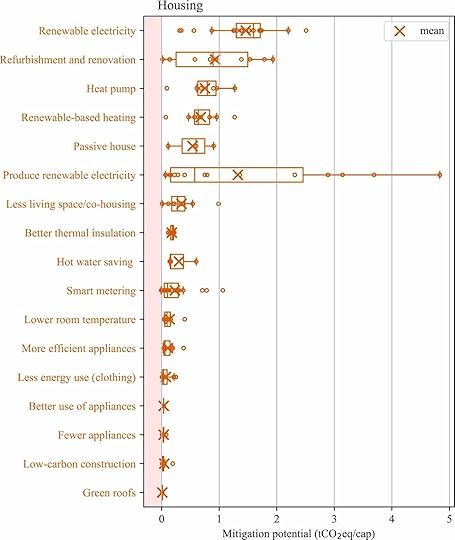 Emissions savings from housing actions. Source: Ivanova et al., 2020.
Emissions savings from housing actions. Source: Ivanova et al., 2020. If you can, get rooftop solar on your house to produce your own renewable electricity. (My housing association just applied for solar permits, and was denied. There is a public hearing full of righteous rage in my future!)
If you can’t go solar, or while you’re working on it, purchase renewable electricity from the provider in your area. (There is some risk that the provider you choose won’t replace dirty energy with clean; but getting renewable electricity is cost-competitive, with big potential upsides, and I’ve decided to do it anyway.)
Next, go for “refurbishment and renovation” (like improving insulation and installing efficient windows), to reduce the energy you need to use to make your home comfortable.
Replace your fossil-based home heating/cooling with an electric heat pump (basically, reversible air conditioners that can both heat and cool your home by moving air around). Gotta love Rewiring America, who sent Mr. Heat Pump to Washington to get people jazzed on this magic, under-appreciated box.
A lot of home energy goes to heat or cool things (including the air temperature in your house, water for washing yourself and your clothes and dishes, and your washer and dryer). This makes big appliances like water heaters the exception to the usual low-carbon rule of thumb to use what you already have, because newer, highly efficient models save a lot of emissions and are worth the upgrade if you can afford it. Heat rooms to max 19°C (66°F), and hot water to 48°C (120°F). Wash clothing in the coldest recommended temp, and hang to dry.
Parting TidbitsI had the pleasure of talking with Rose Aguilar about “How to Be Human in a Warming World” on live radio for Your Call, KALW. She was the best-prepared interviewer I’ve ever had!
I talked to Allyson Chiu at The Washington Post about building the climate cathedral:
“History doesn’t really know their names, and many of them probably didn’t live to see it completed, and they didn’t know where all the pieces were coming from or where everything was going. But they laid their stone or they made their window or they put the wood together. They did the one little piece that they were capable of doing and it did add up to this amazing thing that has really stood the test of time.”
Reading recommendation: How to Do Nothing: Resisting the Attention Economy, by Jenny Odell, convinced me that “thought and dialogue rely on physical time and space,” and helped me work on making better use of mine.
xo,
Kim
August 25, 2022
How to fly less
Hi friends, hope you are enjoying summer! We had a spontaneous picnic dinner in the courtyard with our neighbours this week.
Thanks so much to the hundreds of you who replied to my survey for the personalised climate action guide last month, it was so helpful and I really appreciate it! Updates on the beta version coming soon! :)
If you’re new, welcome! Here’s where you get your expert climate advice:
Now, on to this month’s edition…
Facts: Americans Do Care About ClimateA new study with the very Zeitgeisty title “Americans Experience A False Social Reality” shows that most Americans (65%) ARE concerned about climate change.
But they wrongly THINK others are not. On average, Americans think just 43% are concerned.
The 22% gap between perception and reality means people think the climate-concerned are a minority, when in fact we’re a majority.
The authors describe false social reality as “a near universal perception of public opinion that is the opposite of true public sentiment”. People feel like they live in a different world than the actual one. Underestimating climate concern was found across all 50 states.
The same pattern was true of support for climate policies like 100% renewable energy mandates & a Green New Deal; two-thirds of Americans support them, but they think only about one-third do.
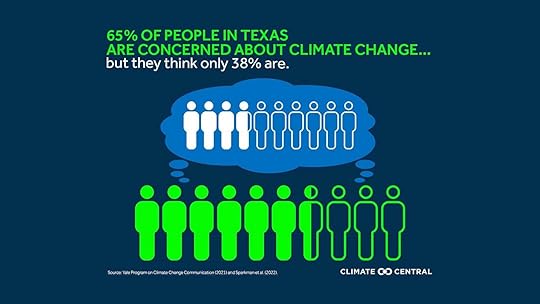 Americans in all 50 states (including Texas, shown here) are concerned about climate change, but under-estimate others’ concern. Graphic: Climate Central
Americans in all 50 states (including Texas, shown here) are concerned about climate change, but under-estimate others’ concern. Graphic: Climate CentralThis misperception that others don’t care about climate can reduce how much people talk about climate, which prevents climate organising. Over-estimating the size of the opposition decreases motivation and political pressure to pursue climate policy.
So, go forth knowing that others do care and are concerned about climate— and talk and act accordingly.
Feelings: Climate DissonanceThe evidence above notwithstanding, sometimes we run into climate cluelessness that can make living with our climate knowledge really tough.
I want to share some words a reader named K. wrote me:
“I’ve barely been able to follow the news because reading/ hearing about droughts, wildfires and dying rivers makes me seriously freak out about my new baby’s future.
And now my company just posted a message celebrating National Aviation Day! They claim that “nearly everyone” flies, but that’s not true— it’s the relatively wealthy that fly, thereby destroying things for those who cannot afford flying, and who are hit hardest by climate change.
They also say that air travel is expected to double by 2035. AFAIK, if air transportation has doubled by 2035 we are seriously f*cked.
How shall I deal with this?”
It reminded me of a piece by the Swedish journalist Jens Liljestrand, called “I’m Tired of Showing My Child A Dying World.” (It’s an incredibly powerful read, even through Google translate for non-Swedish speakers.)
Liljestrand described taking his family diving in Kenya and finding only a reef full of slime. In the car ride back to the hotel, his eleven-year-old daughter broke the silence:
“There were no colors. In all the movies it looks so pretty with all the colors. But now I know that’s just in the movies. It’s never like that in real life.”
Liljestrand declared he was done flying to “take selfies with a dying world in the background.”
For me, my flying wake-up moment came at a climate conference in 2012.
As I wrote about for Scientific American, and in Chapter 9 of Under the Sky We Make:
I knew flying made up most of my personal climate pollution. The hypocrisy that I, and most of my fellow attendees, had flown to this climate conference did not escape me. I was starting to feel like I was attending a conference of doctors puffing on cigarettes while telling our patients to quit smoking.
Over a cold beer after a long day at the conference, I decided to stop flying so much. I was talking to Charlie, a friend with wild hair and even wilder ideas. He was describing his adventurous 15-hour train trip from his home northeast of London. I confessed I’d taken a boring flight from Copenhagen in under 2 hours.
“How do you make your life work without flying?” I asked.
“I decided to stop flying within Europe. It’s doable,” he replied.
Something clicked. I could do that too.
Until that moment, I never imagined all the flying I could reduce, because I would get stuck on the one flight I couldn’t bear to imagine giving up: the one from Sweden to California to see my family, one of the journeys George Monbiot calls “love miles.” But now a middle ground appeared, something I could commit to. I couldn’t do everything right away, but I could start with something.
Many readers tell me that flying less is the hardest change to imagine making, and that seeing others continue frequent flying without thinking of the climate is one of their biggest sources of climate dissonance. So let’s have a look at how to start facing flying less.
Action: Fly less. Yes, you!You already know, dear reader, that if you fly, it’s your biggest source of climate pollution.
Just 1% of the world’s population are regular flyers— and they represent 50% of climate pollution from flights. (I was in that group until I put my frequent flyer card in a museum.) Eeeeeek!
After a big drop in 2020, we see flying rebounding fast right now. But we know that a “recovery” of business-as-usual flying means climate catastrophe. Flying needs to decline, because flying today is at odds with the big-ass reductions in emissions we need to make to avoid blowing all of humanity’s remaining carbon budget in the next 83 months. (ACK!)
A great place to start is to join the Flight Free Campaign, which started here in Sweden. Some chapters, like the UK and US, offer the chance to pledge to go flight-free for a year, to make a significant personal change and work for broader system change. (If work or family commitments mean you can’t go flight-free, you can also pledge to be flight-free for holidays.) Also check out the Stay Grounded campaign.
Some ways to get started or ramp up staying grounded:
Personal flying
The majority of flying (about 80% in Sweden, and 70% in the US ) is for personal, not business, trips.
Most important: Don’t move really far away from people you love! (I personally failed to do this by moving to Sweden in 2010, while my family and many dear friends are in North America. After cutting my flying more than 90%, these “love miles” are the only flights I haven’t eliminated yet.)
Identify which flights you don’t need; cut those first. A recent study of frequent flyers found the travellers themselves rated only 58 percent of their trips “important” or “very important.”
If you can’t stop flying, choose a way to limit your flights: by frequency (e.g., max 1 per year), distance (e.g., no flights within your country or a certain distance), or purpose (e.g., to see loved ones).
For holidays, explore destinations close to home. (I’ve subscribed to the magazine of my local region, Magasinet Skåne, which is full of ideas of biking- or transit-distance hikes, cafes, and excursions. I’m also a member of the national association STF, who run cabins and affordable hostels in beautiful places around Sweden, many accessible with train).
TrainBikeTouring has some beautiful inspiration.
Here are 100 fabulous and climate-smart trips within Europe. (This is how I ended up taking Simon to an extremely fun and rather bizarre tropical resort beach vacation… near Berlin… one late winter.)
Work flying
Start conversations about flying at work, and find at least one person who wants to work towards your organisation flying less.
Get your organisation to use behavioural science to support flying less, following guidance from World Resources Institute to:
(1) Make virtual easy;
(2) Use positive social norms and pledges;
(3) Encourage senior staff to lead new norms by convening explicit travel-reduction conversations; and
(4) Formalize institutional policies and procedures, like changing budget templates or proposal guidelines.
Ready to dive in? FlyingLessResourcesGuide.info is a one-stop shop for everything from practical guides to hosting low-carbon conferences, to getting your organisation or industry to fly less, to how to push for funders and incentives to support flying less.
Join campaigns and communities like FlyingLess.org, which has fabulous resources and stories for academics flying less.
Here’s 4 minutes of me talking about how our department is going about flying less, and here’s a whole podcast on Flying Less!
Make institutional guidance like the Tyndall Centre decision tree to prioritise flights, and start conversations about equity. (Flying is usually distributed very unequally within organisations; their guidelines prioritise flights for younger and less advantaged scholars.)
Get inspired by others who are already leading the way- like these universities who have implemented or are planning measures like:
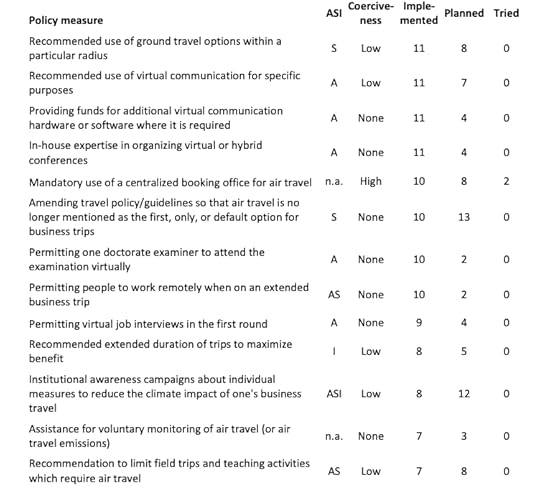 Source: “Reducing the climate impact associated with air travel: Shifting perspectives within & beyond Academia,” by Dr. Agnes Kreil at ETH Zürich, p66
Source: “Reducing the climate impact associated with air travel: Shifting perspectives within & beyond Academia,” by Dr. Agnes Kreil at ETH Zürich, p66 Collective action
Talk about flying less! Many people find this a touchy topic. Maja Rosén of “We Stay On the Ground” has written a warm, smart, empathetic guide to connecting over real conversations. Tips on where and how to have these conversations, and a super-helpful Q&A with arguments and strategies for responding to claims like “We need to keep flying to support tourism” or “Flying increases our understanding of the world.” Watch Maja in this 5-minute interview; she’s brilliant. (For the hardcore, here’s the full guide).
Support campaigns to make flying (and frequent flyers) pay their fair share, like A Free Ride. They advocate a frequent flyer levy, where everyone gets one tax-free return flight per year. Taxes increase for each subsequent flight after the first, and are used to support alternatives to flying.
If you’re a politician or airline industry exec who wants to keep flying alive:
Get cracking on the sweeping investments, regulatory changes, and tech breakthroughs you need to do now and over the coming decades to make flying Paris Agreement-compatible in the future. You can start with this ICCT report and the action checklist (Table 1) from a recent study.
Parting TidbitsI got to talk about climate feminism, embodiment, and what the youth movement can teach the climate movement on the Plugged In Podcast:
I spoke to WIRED about how I overcame my analysis paralysis to start flying less— and what we know works to inspire everyday climate action:
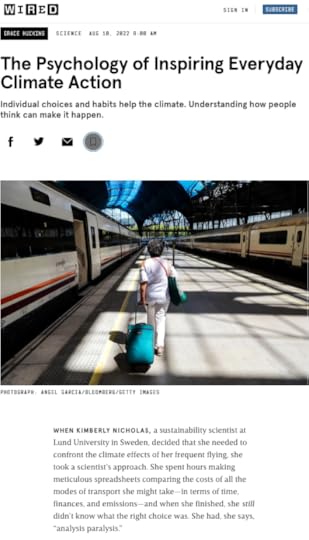
Reading recommendation: Climate Change Coaching: The Power of Connection to Create Climate Action, by Charly Cox and Sarah Flynn, is an empowering and practical guide to strengthening relationships for climate and social care. Not just for coaches, but for anyone (teachers, parents, managers, …) who wants to help people identify their strengths and how they can be of service in the climate crisis.
xo,
Kim
July 29, 2022
Is there a doctor on the planet?
Hi friends, I’m back at the keyboard after a glorious unplugged vacation (did you miss me in your inbox in June??). Simon and I ate all the food, drank all the wine, climbed mountains, read novels, combed beaches, and hugged our family and friends. I’m reminded how nourishing these things are for me. I hope you’re able to have some rest and renewal this summer!
I’ll admit it’s slow to start up work again, but one thing I was excited to dive back into is working on the personalised climate action guide I recently got funding to develop.
I want to make the guide as useful as possible for YOU, dear We Can Fix It reader— so I would be really happy if you would please answer this quick survey (it’s only 3 questions). Thank you!
Without further ado, onto the facts, feelings, and action!
Facts: Climate action for health professionals Image: Fabrice Coffrini / AFP, Grist
Image: Fabrice Coffrini / AFP, Grist Healthcare professionals are highly trusted, and have high leverage to enact change. They are excellent climate messengers and effective changemakers.
But what messages, demands, and behaviours line up with health professionals’ expertise in protecting public health, while also making a real difference for climate?
Happily, Seth Wynes just answered this question in a new comment, currently available as a preprint. He writes,
“Advocating for governmental climate action, advising their patients to enjoy healthier, low-carbon lifestyles, and modeling the low-carbon transition in their homes and workplaces are key strategies that leverage health professionals’ existing strengths.”
Highlights of Seth’s evidence-based climate action guide for healthcare workers:
Climate advocacy
Join existing organisations
Get media attention.
Focus on elections: endorse bold climate candidates and ballot initiatives.
As a private citizen
Call or meet with your rep (tips from We Can Fix It, March 2021).
Vote for and donate to strong climate candidates.
Local politics
“City councils that zone for endless single-family neighbourhoods are building environments that override residents’ ability to make good decisions for their own health and for the climate. If Chambers of Commerce can actively lobby for more car infrastructure and its accompanying sprawl, then physicians should feel empowered to lobby for the opposite.
Few voices are likely to resonate more at a municipal council meeting than a trusted general practitioner explaining the link between urban form and health outcomes. Likewise, paramedics and emergency room professionals can describe to city councils the frequency and severity of injuries they treat from car crashes, while physiotherapists can elaborate on the lingering disabilities caused by those same incidents.”
Lobby your city council
Support compact, walkable, mixed-use neighbourhoods.
Support initiatives that disfavour cars and promote pedestrians and cyclists, like congestion charges, reduced city parking, and infrastructure for walking and biking.
National politics
Support policies to power electricity and transport with clean energy that will be passed and implemented quickly.
Appropriate policies depend on context, but generally make fossil fuels less convenient and more expensive, and subsidise, encourage, or require renewable energy production, storage, or transmission. Healthcare professionals can let policymakers decide on the best mix of incentives and regulations, but should “side forcefully against [doing] nothing.”
Advising patient lifestyles
Encourage plant-rich diets and active lifestyles (like living close to work, and walking or biking there).
Recommend replacing gas stoves with electric (especially to new parents; the fumes are especially harmful to developing kids) and replacing gas furnaces with electric heat pumps.
Role modelling
Take high-impact climate actions yourself: avoid air travel; go car free, or get an electric car; eat a plant-based diet. Practicing what you preach makes climate advocacy more persuasive.
As a professional
“[H]ealth professionals can aim to influence workplace norms, hiring practices, building emissions, and purchasing strategies that are currently high in carbon.”
Switch residency interviews to digital, or a centralised location.
Work to reduce supply chain emissions by better measuring and managing the climate impact from facilities like clinics, schools, hospitals, and vehicle fleets.
Read Seth’s full advice here, and share with your favourite doctor, nurse, paramedic, physiotherapist, and other health professional.
Hungry for more? Check out this recent special issue on climate and health solutions from healthcare professionals, with topics like greening conferences, discussing climate change in clinical encounters, med school climate curricula, and reducing clinic waste.
Feelings: Feeling the Climate Love!After 2+ years of almost entirely virtual interactions with colleagues and readers, it’s been soul-filling to start meeting face-to-face with nearby folks.
On one of my precious trips home to Sonoma, California last month, Simon and I were lucky to be hosted for lunch in Healdsburg by a group of friends and neighbors who got together to read Under The Sky We Make. (In Chapter 9, I write about how I’ve reduced my flights more than 90%, and my expired frequent flyer card is where it belongs— in a museum, but I still take an annual flight home to see family.)
After reading and discussing, the group decided to form We Are Talking About It— a monthly gathering to help channel their climate despair into action. They’ve become an amazing local climate action powerhouse. Group members are attending city council meetings, hitting the streets with creative demonstrations, growing their own (delicious!) veggies, taking train and bike holidays, contributing labor for local farmers, reducing wine packaging, setting up a table to talk about climate action at the local farmers market, and more.
Sitting around a table in dappled shade, sharing food and wine grown with care on the beautiful rolling hills surrounding us, what struck me was the group’s joy. It shone through from their shared stories and laughter, and their active listening and support for each other.
 We Are Talking About It members hosted me and Simon for a lovely lunch and chat. (It was Simon’s first vineyard visit!) Photo: We Are Talking About It
We Are Talking About It members hosted me and Simon for a lovely lunch and chat. (It was Simon’s first vineyard visit!) Photo: We Are Talking About It It was a great reminder that we all need to keep refilling our cups— and one of the best ways to do so is together. As the We Are Talking About It gang shared in their post, “taking time to rest, restore, laugh, have a picnic, and make new friends is a tool to help keep us going.”
Action: Wine industry climate leadershipI grew up on my family’s vineyard, and studied the impact of climate change on winegrowing in Sonoma and Napa for my PhD. Wine is close to my heart!
So I am very heartened that the wine industry is taking climate leadership seriously. One of my favourite initiatives is:
International Wineries for Climate ActionWhat I love about this group is their clear, science-based approach. IWCA focus on what matters most: *actually reducing emissions*. Members who join do this by:
Measuring current baselines and annual emissions to inform reduction strategies (they’ve created an Excel greenhouse gas calculator to help). Remember, “What gets measured, gets managed.” Check out their members’ data below!
Not just committing to Net Zero 2050 (reminder from We Can Fix It May 2021 on why that’s not enough), but also to make ongoing reductions to meet 2030 goals. Check out their rigorous membership requirements— no room for greenwashing here!
Sharing knowledge on best practices to inspire industry action, like in their report on regenerative farming.
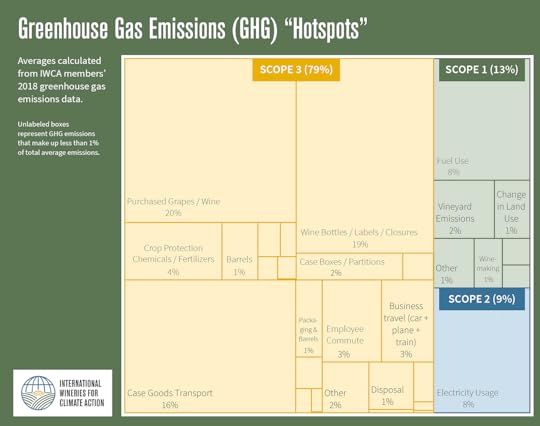 Data to make this wine + climate nerd’s heart sing. Scope 1 = onsite emissions under direct control; Scope 2= electricity; Scope 3 = purchased products and services. Source: International Wineries for Climate Action.
Data to make this wine + climate nerd’s heart sing. Scope 1 = onsite emissions under direct control; Scope 2= electricity; Scope 3 = purchased products and services. Source: International Wineries for Climate Action.At the recent Napa THRIVES event, Educational Winemaker & Sustainability Manager Molly Sheppard shared emissions data from Spottswoode Estate. While they’re committed to make ongoing improvements in the vineyard and winery, Spottswoode is already near the cutting edge in terms of best practices for their own operations (called “Scope 1” emissions). There isn’t a lot more room to cut Scope 1 emissions.
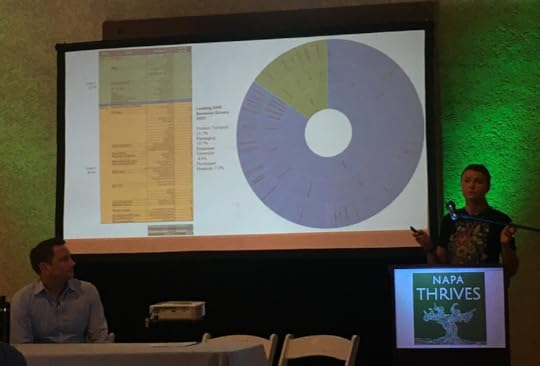 Molly Sheppard shares Spottswoode’s emissions inventory at Napa THRIVES. Photo: Kim Nicholas
Molly Sheppard shares Spottswoode’s emissions inventory at Napa THRIVES. Photo: Kim Nicholas With about 80% of their total emissions coming from goods and services that Spottswoode purchases, like packaging and shipping their wines (Scope 3), Molly noted the need for collaboration across the whole supply chain: “Your Scope 3 emissions are someone else’s Scope 1.”
Led by President and CEO Beth Novak Milliken, Spottswoode is also thinking about how they can share their story and love of wine to inspire their customers to take more climate action. (They generously included a copy of Under the Sky We Make with a recent wine shipment to their top customers!)
If you’re looking to learn more about climate change and wine, check out “What Can Wine Tell Us About the Future of Life On Earth?” (45 min talk), “Wine Lover, the Climate Needs YOU!” (15 min talk), or my article for Scientific American, “Will We Still Enjoy Pinot Noir?”
Parting tidbits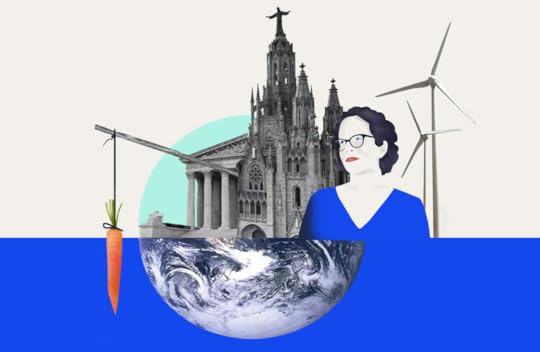 Read my interview for Climate Pioneers on the power of emotion to get into motion, exploitation vs. regeneration, and cathedral thinking. Image: ClimateView
Read my interview for Climate Pioneers on the power of emotion to get into motion, exploitation vs. regeneration, and cathedral thinking. Image: ClimateView VoltsVolts podcast: Kimberly Nicholas on the best ways to get cars out of citiesListen now (43 min) | In the US, the movement to get cars out of cities is … what’s the nice word? … nascent. But in Europe, where many cities were built before cars and big-box sprawl never completely dominated, there is growing agreement that cars need to be reigned in. It’s partly about fighting climate change, but beyond that it’s about quality of life — living without a…Read morea month ago · 25 likes · 2 comments · David RobertsBook recommendation
VoltsVolts podcast: Kimberly Nicholas on the best ways to get cars out of citiesListen now (43 min) | In the US, the movement to get cars out of cities is … what’s the nice word? … nascent. But in Europe, where many cities were built before cars and big-box sprawl never completely dominated, there is growing agreement that cars need to be reigned in. It’s partly about fighting climate change, but beyond that it’s about quality of life — living without a…Read morea month ago · 25 likes · 2 comments · David RobertsBook recommendationTo Boldly Grow: Finding Joy, Adventure, and Dinner in Your Own Backyard, by Tamar Haspel. Great reading for this time of natural abundance. Accessible, unfussy, hilarious inspiration to get outside and learn about first-hand food by growing and harvesting it for yourself.
And on that note— I’m off to glean cherries and pick gooseberries and the first round of apples from our tree. Have a lovely weekend!
xo,
Kim
May 26, 2022
“Between the things we hope for and the things we're afraid of”, with Dr. Britt Wray
Hi friends,
Welcome to my first-ever podcast episode! We Can Fix It is going multi-media, baby!
I’ve been writing a (mostly) monthly newsletter of evidence-based climate advice at We Can Fix It since January 2021. This month’s newsletter features an interview with the wonderful Dr. Britt Wray, where we discuss switching careers to work on climate, holding on to both fear and hope in uncertainty, being one tiny drop in a tidal wave of change, and more.

I was only able to excerpt a fraction of our conversation to fit in the newsletter, and I was so inspired by Britt’s words that, with Britt’s permission, I wanted to share the full conversation with you here.
Our conversation is inspired by Britt’s new book, Generation Dread, which you should definitely buy and read immediately.
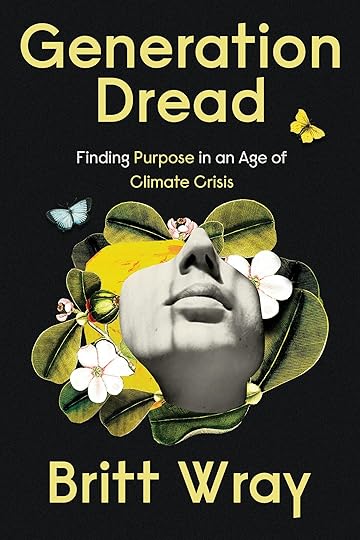
I hope you enjoy listening; please let me know what you think!
xo,
Kim
"Between the things we hope for and the things we're afraid of": Interview with Dr. Britt Wray
Hi friends,
This month I am grateful to share with you some words of wisdom that have helped me in this painful and beautiful moment to be alive, from my first-ever We Can Fix It interview featuring Dr. Britt Wray, an author and researcher on climate and mental health.
I have long admired and learned from Britt’s leadership in facing the climate crisis with eyes and heart wide open, which she shares at her Gen Dread newsletter. Britt isn’t afraid to say the hard parts out loud, always with self-awareness and empathy that makes her words resonate even more deeply.
I devoured her new book, Generation Dread, and am honoured to have the chance to speak with her about it, and to share her insights with you. I hope it provides some comfort and courage for you to keep nourishing yourself, and to keep doing the work the world needs. As Britt says, “We all are tiny drops as individuals, but we are needed in this tidal wave of change.”

On to the facts, feelings, and action!
Facts: Google maps for city climate actionDid you know Google can tell you how much of your city’s emissions come from driving versus buildings, map trees and air quality by street, and show where there’s potential for rooftop solar?
I learned this in a presentation from Anna Williams from Google, who introduced the Environmental Insights Explorer tool at the ICLEI Congress in Malmö.
These data are super useful because, to reduce emissions in practice, we need to:
Identify climate pollution at its source.
Stop doing things that cause climate pollution.
Replace with things that don’t cause climate pollution.
But soooo many people who want to help don’t know the answer to #1. If you don’t know the biggest sources of emissions for your city, country, business, or household, you risk misdirecting effort away from where it’s most needed.
As Alexi Lynch of Ironbark Sustainability reported in a case study of using the tool:
“Be open to letting the data and evidence change your direction and focus for climate action. You might find you’ve been knocking on the wrong areas to reduce emissions — and that’s OK. We’ve all had to pivot at times…. use the tools to then move onto the important task of planning and delivering on climate action in the right areas.”
Australia has drawn from the Google EIE data for 537 Australian municipalities cities in a platform called Snapshot to make emissions overviews to inform climate plans:
 Profile of emissions from Darebin, Australia, created using Environmental Insights Explorer data. Source: Google Earth on Medium.
Profile of emissions from Darebin, Australia, created using Environmental Insights Explorer data. Source: Google Earth on Medium. The data are freely available, but Anna told me the tool is designed for one person from each city (an employee, consultant, or NGO working for city government) to register to the database and serve as the main point of contact. (This approach gives city officials a chance to review and understand the data before making them public).
So: send your favourite city employee this email and tell them to sign up to access here, then make the data public for your city so you can help choose and implement the practices that will most reduce emissions for your city. Entice them by saying they’ll get wonk-worthy data like these:
 Free emissions data for cities including modal split to inform high-impact climate action. Swoon. Source: Google IEI Feelings: “Between the things we hope for & the things we're afraid of”
Free emissions data for cities including modal split to inform high-impact climate action. Swoon. Source: Google IEI Feelings: “Between the things we hope for & the things we're afraid of”I’m so glad to share this conversation with Dr. Britt Wray inspired by her new book Generation Dread, a book that the world needs, and that I needed. This excerpt has been edited for structure and clarity.
Kim: How was the idea for Generation Dread born?
Britt: My reckoning with eco-anxiety became so severe that I couldn’t rely on my soft denial tendencies to turn away out of self-protection any more, which a lot of us unwittingly do. This was ultimately productive, because it helped me turn the difficulty into meaning-focused coping.
Working on this book allowed me to broaden out my view of the future, to muster hope and optimism, and alternative ideas that are also true about the future. One way to do this was by bringing in lots of other perspectives and learning from them, including from people who’ve been living with existential threat for a long time, for whom the fact that they don’t feel like the world is a safe place is nothing new.
Kim: How did you make a career shift into climate, and what’s your advice to others considering the same?
Britt: Quitting my old field of work, coming to work on climate issues, made everything feel a lot more purposeful, and it helps address the threat that was stressing me.
I understand that not everyone can afford to change their career. But if you do have the flexibility, even if it’s daunting and challenging, I would encourage you to do it.
We are at a moment where we need a billion climate activists. We just do.
Using your daytime and your livelihood space, the most powerful time when you’re not sleeping or engaged in domestic responsibility duties, to channel your energies towards something that really matters... it helps the movement, it helps you to choose something that’s most existentially purposeful and meaningful for you, and it will help you feel more alive. That’s what I’m finding. On your deathbed, it will increase your life satisfaction.
Kim: How do you live with worsening external circumstances and uncertainties about the future?
Britt: The future isn’t written in stone. Uncertainty of how bad it’s going to get doesn’t need to be something we’re just fearful of. It can be a huge leveraging tool for getting to work.
We can hold on to uncertainty as a potential opening up of the future for good things to happen; to being our best, most caring, compassionate selves, and applying morality to our lives.
There’s a liberatory aspect of knowing things are getting harder, and going through the process of grieving and owning up to that, while also understanding it will only get as bad as we let it.
We have to use that motivation from our fear to jolt us into meaningful action, to get to work with each other. Once you act, you produce the hope you want, from rolling up your sleeves and earning the hope, rather than simply having it.
We all are tiny drops as individuals, but we are needed in this tidal wave of change. Your drop is as important as everyone else’s drop. Your actions, even if small, do matter. You always have something available to you, even if it’s so easy to feel helpless in this crisis.
As we move forward, it’s going to be challenging, but there’s also lots of opportunity to inject it with joy, our collective courage, all the love that is already around to make being alive beautiful.
Kim: Why is it so important to get beyond binary thinking in the climate crisis?
Britt: Binaries are really inadequate for facing up to and moving through the complexity of the climate crisis. Only focusing on the scary stuff forecloses the idea of what’s possible, and can lead to self-fulfilling prophecies of doomism: the belief that action is futile, so you don’t take it, which leads to more negative consequences.
We can try to take a non-binary approach to emotions like fear, hope, courage, sadness… they all have important things to teach us right now. We need to get better at feeling them, and letting them move through us, and teach us things as they do move through us.
I know holding this tension of conflictedness can be unsatisfying. People want answers and cognitive ease. But that is just not what’s on deck with the climate crisis.
It’s about trying to balance and move forward with the best of our cognitive capacities, where we’re not so hypervigilant with stress that we’re only reactive and rigid, but we’re not naively optimistic and letting down the urgency to act.
We need to be able to bear cognitive dissonance. We can do that.
We have to live in that grey space and hold that tension between the things we hope for and the things we’re afraid of, and know that they’re both true dynamics of the climate crisis.
Kim: What are your practical tips to work on the skill of existing in that uncomfortable, non-binary grey space?
Britt: Something that’s super painful for a lot of people is feeling like they live in a split world. They’ve had a climate awakening, and they’re so awake to the scary things barreling at us, to human suffering and conflict. At another moment, let’s say a parent is playing with their child, reveling in the innocence of a nice walk in the park. The sky isn’t falling, the sun is shining. This split sense of self is really difficult to reconcile within an individual.
Something that has really helped me is meditation. Being able to ground oneself in the present moment is huge. You focus on what is real in this moment, rather than hypotheticals. It brings you into the non-dualistic nature of reality. You realize there has always been joy and suffering in the world; they are inextricable.
It's important to notice when you’re at your edge, getting outside of your window of tolerance, and then take a step back and think about the basics: eating, sleeping, exercise, connecting with someone you love. You’ll know what works for you, if it’s cooking, gardening, or climate-aware therapy, the burgeoning cottage industry of climate coaches, or validating and connecting over concerns in support groups.
Black feminists like Audrey Lorde tell us that self-care is a political act because we have to fill ourselves up to be able to take on the external struggles we have to push against, and we can’t do that if we’re depleted. We need to nourish ourselves for the long haul to carry and stay with the trouble of this crisis for the rest of our lives.
Kim: What is your dream for Generation Dread? What impact do you hope this book can contribute?
Britt: I hope it can be a salve for people who find themselves on the harsher end of climate distress, to step out of isolation and towards understanding and connection with others over how they’re feeling. That they can take these emotions and realize, it creates bridges of solidarity, courage, and commitment, and they can transform difficult feelings to something more constructive for them, and for the planetary health crisis.
I also want to put on the map that we need to think deeply about shifting how we address mental health care in society at large. The one-on-one biomedical model is already not enough. There aren’t enough therapists to address the pandemic fallout, and it’s expensive. There are solutions we can use from getting global mental healthcare into low-resource settings. For example, training peer counselors and lay workers to help others in their community; clinical trials show how effective this can be.
At a policy level, I hope to alert decisionmakers that we have choices about how we’re going to react in these choiceless events. We can still help bring about more effective ways of preventing harm to mental health, and support communities to deal with disasters and recover afterwards.
Please read and share Generation Dread with those who can benefit from it, from your eco-anxious cousin to your old college roommate now working on mental health policy!
Subscribers will get access to the full audio of our conversation in an email tomorrow- stay tuned!
Action: Faculty for a FutureWrestling with how to serve society in an era of colliding environmental and social crises?
Yep, me too!
Every day, more people are increasingly aware that business as usual cannot continue. But how can we use our jobs to help work towards the world we want?
One initiative trying to figure this out for academia is Faculty for a Future. They aim to “help academics who feel a duty of care over Earth’s colliding crises to transform research, teaching, and public engagement for a better future,” including by “attracting new funding streams that allow academics and other stakeholders to equitably collaborate” in making these goals a reality.
As Chief Executive Jordan Raine says, “I’m going to do everything in my professional power to make sure what I do safeguards life on this planet.”
It’s early days; the initial launch of Faculty for a Future was just last week, with many of their first products like an open-access teaching repository being rolled out over the summer. Academic Lead James Dyke acknowledges the need to experiment and learn in navigating these uncharted waters. While there are clear goals and six principles for understanding the emergent world on the website, he admits he doesn’t know exactly where Faculty for a Future is going to go, but James insists:
“There’s gotta be something else we [as academics] can do to connect our practice, our day jobs, with the real concerns we have about where we’re heading. There’s gotta be something between writing a paper and spending a night in jail. There’s tremendous latent power in academia where we can do something really transformative.”
I was honoured when Faculty for a Future invited me to serve on their Advisory Board, and I’m excited to see how this work develops.
To get involved, you can:
Join one of the 90-minute virtual launches in July for the Teach for a Future, Research for a Future, or Communicate the Complex Crisis projects
Contribute your expertise! Faculty for a Future is looking for beta testers to design, test, and use their open-access teaching repository; help develop the Research Hub linking researchers, practitioners, and creatives; share stories, resources, and inspiration with your networks; and more. Have a look at their projects to find where you can jump in.
Join! (It’s free.) Use the link to express your interests and stay in touch with updates.
More resources for academics to roll up our sleeves:
Sweden’s concise Climate Framework for Higher Education Institutions Guidelines include 13 areas of action with specific research-based steps universities should be taking now, from finance to procurement to campus operations, travel, teaching, and research.
The comprehensive new ALLEA report Towards Climate Sustainability of the Academic System has advice for conferences, academic air travel, funding organisations, policymakers, and more.
For recent grads (congrats!):
Share these words from my climate crush UN Secretary General António Guterres, whose commencement speech called for grads to boycott jobs in fossil industries:
Parting TidbitsI have some good news to share!
“As graduates, you hold the cards. Your talent is in demand from multinational companies and big financial institutions. You will have plenty of opportunities to choose from. My message to you is simple: Don’t work for climate-wreckers. Use your talents to drive us towards a renewable future.”
-UN Secretary-General António Guterres
Hey, my proposal to the Swedish Research Council FORMAS was funded! This 2-year project will support developing new ways to get evidence-based climate action advice into the hands of those who need it, including a personalised climate action guide, a podcast, and social media materials. I’ll share updates with you here, including an invite to beta-test the interactive guide when I have an early draft ready!
Our study on the 12 best ways to get cars out of cities was cited in an editorial in Sweden’s top national newspaper, Dagens Nyheter, titled “The way forward is to drive less,” calling out politicians for their short-sighted policies continuing to favour cars that don’t add up to meeting their climate promises. I’m really grateful to all who’ve shared it with and demanded accountability from your city leaders (including this piece from my local newspaper Sydsvenskan about Lund’s response), or otherwise used it in your work.
Listen: I talked with Laura Diez on the ECO CHIC podcast about facing climate grief, being a climate citizen, and the value of community.
Read: Generation Dread, by Dr. Britt Wray, really reached out from the page and grabbed me. It is so affirming and helpful to have such an honest, unflinching, love-filled guide to acknowledging and coping with All The Climate Feels. Get your copy stat!
xo,
Kim
April 28, 2022
Move Over, Cars! 12 Ways to Prioritize People
Hi friends! I’m really glad you’re here. Recent news has me thinking how much I appreciate this We Can Fix It community. Among many other reasons, I’m glad it’s not dependent on a specific platform. If Substack evaporates, I have your emails and my writing, and can recreate it somewhere else. So thanks for being here, and please keep an eye out for a survey coming soon so I can get to know you and how I can serve you better. <3
On to the facts, feels and action!
Facts: 12 ways to free cities from carsAs a We Can Fix It reader, you know that, for the average household in North America or Europe, cars are the biggest climate polluter.
But good news! Dozens of cities have already put in place measures that worked to demonstrably reduce cars and support sustainable mobility, creating more space and cleaner air for people.
In a study led by the wonderful Paula Kuss (developed out of her masters’ thesis!), from screening nearly 800 cases, we identified 12 ways that have *already worked* to reduce cars in cities.
Here are the 12 measures, ranked by effectiveness, in artistic format! (It would make a great coffee mug, don’t you think??)
 A dozen effective measures to reduce car use in cities. Thanks to Emma Li Johansson for the illustration! Featured in The Conversation.
A dozen effective measures to reduce car use in cities. Thanks to Emma Li Johansson for the illustration! Featured in The Conversation.And here are the 12 measures in wonk-friendly table format!
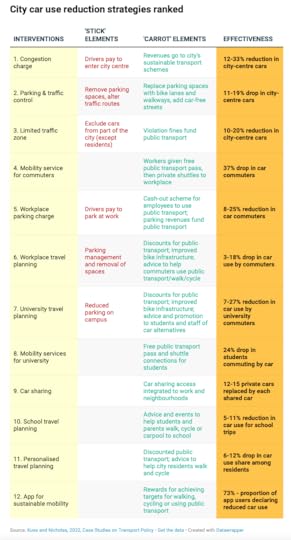 A dozen effective measures to reduce car use in cities. Table from my article in The Conversation.Key takeaway 1: Effective measures combine sticks and carrots.
A dozen effective measures to reduce car use in cities. Table from my article in The Conversation.Key takeaway 1: Effective measures combine sticks and carrots. You already know that getting people to drive less is what’s needed to reduce emissions, and carrots alone don’t work to get people out of cars.
Our analysis shows that effective measures need to address driving and parking reduction and restriction as an explicit goal (the red “sticks” column above)— and then use the space freed and the money generated to expand and improve walking, biking, and public transport (the green “carrot” column above).
Many people on Twitter said, “You forgot bike lanes!”
No, I didn’t. They’re part of #2, 6, and 7, for example. It’s just that bike lanes ALONE weren’t found effective to reduce cars. Carrots AND sticks.
Key takeaway 2: Local city government must lead.We found 75% of the effective measures were led by local government, often in collaboration with employers, universities, or transport providers.
But! We know politicians don’t hear enough from their constituents supporting bold climate policies.
So: please go right ahead and forward this email to your local city leaders, and ask them to implement evidence-based car reduction policies.Don’t forget your favourite:
mayor
city council members
city and transportation planners
cycling, walking, and sustainable mobility groups
disability rights groups (see this excellent report from Possible on how reducing unnecessary cars benefits those who truly need them).
You can also tag your leaders in my posts about this research on Twitter, LinkedIn, or Instagram. Or share our piece in The Guardian on the measures and the cities that have put them into practice. :)
And if you’re hungry for even MORE, read what my editor called “an evidence-based rant against cars” for The Conversation, where I explain why:
electric cars don’t solve the problems of cars
cars today exacerbate social inequalities
focusing explicitly on reducing cars, not only increasing sustainable mobility, is necessary
governments should stop subsidising cars and driving
policies have to change to overcome the playing field now tilted towards cars
Excited to hear how you use these measures to make your city better!
Feelings: Squirming Over InfightingHere’s a feeling Climate People don’t talk about much: discomfort, distress, or worse over internal group dynamics where people who share a goal of a fast and fair transition to a fossil-free world fight with each other. Eeeeek.
Of course, we need to get the facts straight, and robust discussion about strategies are welcome. Of course, it’s important to listen with humility to people operating from good faith.
But I’ve been noticing a big uptick in infighting, blame, and defensiveness on Climate Twitter, and it really bums me out. A circular firing squad doesn’t seem like the way to build the world I want to live in. It also takes time and energy away from the actual work we need: dismantling the systems of power that lock in exploitation, and rebuilding them towards regeneration.
My armchair analysis is that everyone is overstretched personally, and climate scientists are exhausted from screaming into the void for decades, and things in the world are not going well, and people are lashing out at each other. Which is understandable, but not great.
It makes me wonder: What would lead to more generative and fruitful conversations? How can Climate People express concerns, doubts, worries, or observations in a way that leads to support, reflection, and mutual learning, rather than personal judgment, defensiveness, or criticism? Is the nature of social media exacerbating this problem? What kind of forum or platform would let people exchange ideas more constructively?
I don’t have the answers to these questions, but I would love to hear what you think in the comments below!
You know who is fired up about climate action? Museums!!
I heard a lot of great ideas at the Spring Meeting of Swedish Museums this week. The whole meeting was themed around the role museums can play in the climate crisis. (Can you get your next professional conference to adopt a climate theme??)
If you work in the arts, culture, with museums, or visit museums, take some inspiration from the points below!
And if not— how can you adapt these ideas to your sector??
Museums for FutureMatilda Eriksson of Museums for Future gave a fabulous talk where she invited museums to ask themselves how they can serve society in the climate crisis. (A good question for all of us!!)
She shared four points from the Declaration of Museums for Future:
1. Support climate strikesMatilda offered reassurance of nonviolence and solidarity, and suggested museums start by asking youth climate activists “How can we support each other with our unique talents and resources?” (Again, great climate convo starter generally.)
 Source: Museums for Future2. Communicate to the public
Source: Museums for Future2. Communicate to the public Museums can use their collections to draw attention to the climate crisis, including by putting #ObjectsOnStrike or pointing out problematic ties with fossil fuels.
@PrivateEyeNews covers it! 👇\n\n@NPGLondon #fossilfreeculture ","username":"Cult_Unstained","name":"Culture Unstained","date":"Wed Mar 16 10:28:19 +0000 2022","photos":[{"img_url":"https://pbs.substack.com/media/FN9uGw... Culture Unstained @Cult_UnstainedYou know a win is BiG when @PrivateEyeNews covers it! 👇@NPGLondon #fossilfreeculture
Culture Unstained @Cult_UnstainedYou know a win is BiG when @PrivateEyeNews covers it! 👇@NPGLondon #fossilfreeculture 
March 16th 2022
10 Retweets40 Likes3. Transform our institutions to be part of the solutionMuseums can focus on their own operations, both practically in terms of eliminating emissions, and how they work to support a fast and fair transition.
4. Raise awareness in our networksOur relationships are powerful. Museums for Future urged museums to “use our voices to spread awareness about the necessity of immediate climate actions” among museums, employees, management, and decision-makers.
How can you adapt these four points for your sector??
Making Culture Regenerative— Bridget McKenzieBridget McKenzie of Climate Museums UK gave an inspiring talk. She suggests:
Be “Possitopian”- while “A techno-utopian future view is creating a dystopian reality”, Climate Museums UK aims to be neither utopian nor dystopian, but rather to “approach future thinking by expanding the cone of the possible future”. A critical 21st century skill!!
Bridget argued the cultural sector should reimagine its role, to help people cope with the traumas of the Anthropocene (Earth, biosphere, climate, human, and intersectional), feel possibilities, enable them emotionally to take effective action, and develop eco-capacities.
Bridget offered a vision for museums to contribute to regenerative culture and embed themselves in Kate Raworth’s Doughnut Economics framework, by for example decolonising culture, decarbonising cultural practices, and using arts for truth-telling and cultural therapy and care. This framework has been taken up by Culture Declares emergency.
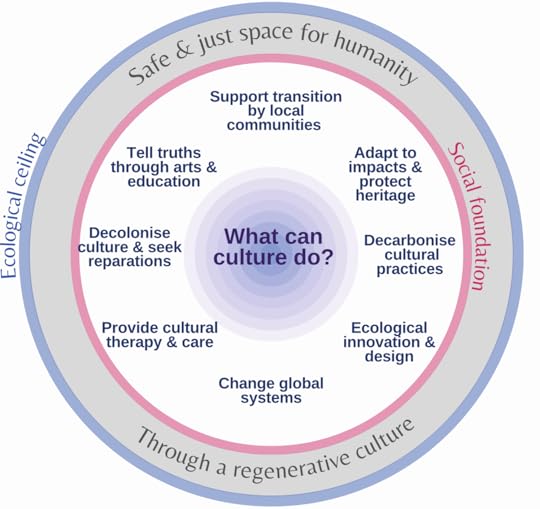 Culture Takes Action: Pathways by Bridget McKenzie.From the United Nations to Your Museum
Culture Takes Action: Pathways by Bridget McKenzie.From the United Nations to Your Museum Henry McGhie of Curating Tomorrow has an excellent series of free guides, like Action for Climate Empowerment, that translate the United Nations Sustainable Development Goals into suggestions for what galleries, libraries, archives and museums (GLAM!) can do:
as a sector,
at particular institutions,
and as individual workers,
with suggested metrics.
It’s super practical and clear. I would love to see more guides like this for every sector!
Awareness through ArtMatilda Eriksson shared a powerful collaboration between WWF and Museo del Prado, to digitally alter paintings from the collection to draw attention to climate impacts in billboards across Madrid.
 El paso de la laguna Estigia (Landscape with Charon Crossing the Styx), Museo Del Prado. Image: BBC
El paso de la laguna Estigia (Landscape with Charon Crossing the Styx), Museo Del Prado. Image: BBC
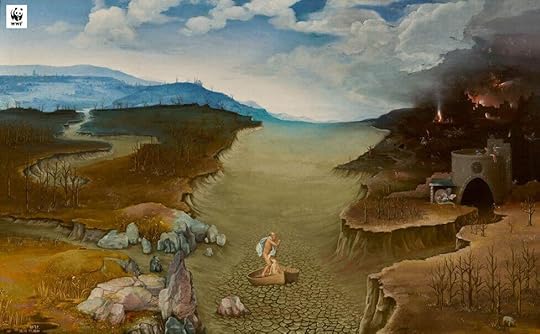 Painting modified by Museo Del Prado/WWF. Image: BBC
Painting modified by Museo Del Prado/WWF. Image: BBCGut punch, right?
What examples of climate art have you seen? Please share in the comments below!
Parting TidbitsListen: I spoke to Carlton Reid on The Spokesmen podcast on why climate scientists are getting desperate (5:00), why building great bike lanes isn't the solution to reducing cars (13:50), how to make car reduction politically palatable (29:45, 38:20), & why all cars need to be fossil-free but the best car is... a bicycle (51:20, 46:00). Enjoy!
Read: A book I got to read last year and blurb is finally out, and it’s so good! Return to Nature, by Emma Loewe, is an antidote to burnout and a gentle invitation to expansive possibilities for awe, restoration, and gratitude right outside your front door, through accessible rituals, simple mindset shifts, and solid practical advice on how we can better care for nature in our everyday lives as consumers and citizens.
Take care friends! Get outside and enjoy April. Tulips are blooming here in Lund!
xo,
Kim
March 31, 2022
How to Help in Disasters
Daffodils are blooming and birds are singing outside my window here in Lund, Sweden— infusing fresh energy for climate action powered by facts & feelings!
Welcome if you’re new to this monthly dose of advice from me, your local climate scientist— you can subscribe here:
Facts: Living well within limitsWe live on a planet with limits. As I wrote in Under the Sky We Make:
Our success or failure as a species now depends on how we learn to live well within some fundamental limits of the biophysical world, by adapting our societies to provide essential needs, rights, and freedoms within the limits of nature. As Jonathan Foley writes, limits can be seen through the lens of opportunity and abundance, not just scarcity.
In recent years, several uncomfortable limits have become clear, starkly highlighted by the IPCC Climate Report on impacts and adaptation last month:
There are limits to the climate impacts that we can prepare for or tolerate. Humans no longer have a choice “between” preventing and preparing for climate impacts; we must do both. But there are limits to what we can prevent or prepare for, which we are approaching every day we burn fossil fuels.
#climatechange. \"Soft\" limits mean options exist, but aren't currently used; they can be overcome w/ more money & better policy. \"Hard\" limits mean no options exist to avoid harm (warm water corals) #IPCC #ClimateReport C.3 11/n","username":"KA_Nicholas","name":"Prof. Kimberly Nicholas","date":"Mon Feb 28 18:09:44 +0000 2022","photos":[],"quoted_tweet":{},"retweet_count":20,"like_count":84,"expanded_url":{},"video_url":null}"> Prof. Kimberly Nicholas @KA_NicholasIt is not possible to adapt to every harm caused by #climatechange. "Soft" limits mean options exist, but aren't currently used; they can be overcome w/ more money & better policy. "Hard" limits mean no options exist to avoid harm (warm water corals) #IPCC #ClimateReport C.3 11/n
Prof. Kimberly Nicholas @KA_NicholasIt is not possible to adapt to every harm caused by #climatechange. "Soft" limits mean options exist, but aren't currently used; they can be overcome w/ more money & better policy. "Hard" limits mean no options exist to avoid harm (warm water corals) #IPCC #ClimateReport C.3 11/nFebruary 28th 2022
20 Retweets84 LikesLimiting warming to 1.5°C is true red line for people and places around the world. Lots of current plans aim to keep burning fossil fuels for decades, “overshoot” the 1.5°C limit, then (somehow…) remove a lot of carbon from the atmosphere to lower temperatures later. Even if this were technically possible (unclear), nature will not be fooled by this approach. There will be irreversible impacts over 1.5°C, like sea level rise and species extinction, that will not be fixed if temperatures return to 1.5°C later.
#IPCC #ClimateReport B.6 8/n","username":"KA_Nicholas","name":"Prof. Kimberly Nicholas","date":"Mon Feb 28 17:57:54 +0000 2022","photos":[],"quoted_tweet":{},"retweet_count":77,"like_count":162,"expanded_url":{},"video_url":null}"> Prof. Kimberly Nicholas @KA_NicholasIf we warm over 1.5°C, it will cause severe problems that cannot be undone, even if it cools later. Cooling after 1.5°C will be harder because nature will have lost a lot of carbon from burned and dying forests, drying wetlands, & thawing permafrost. #IPCC #ClimateReport B.6 8/n
Prof. Kimberly Nicholas @KA_NicholasIf we warm over 1.5°C, it will cause severe problems that cannot be undone, even if it cools later. Cooling after 1.5°C will be harder because nature will have lost a lot of carbon from burned and dying forests, drying wetlands, & thawing permafrost. #IPCC #ClimateReport B.6 8/nFebruary 28th 2022
77 Retweets162 LikesThe next, oh, 87 months or so are humanity’s only chance to prevent catastrophic warming. Industrialised countries need to be reducing emissions about 10-12% per year… that’s about 1% PER MONTH. Look back over previous We Can Fix It editions if you need some inspiration for how!
#IPCC #ClimateReport D.5 18/n","username":"KA_Nicholas","name":"Prof. Kimberly Nicholas","date":"Mon Feb 28 21:52:58 +0000 2022","photos":[],"quoted_tweet":{},"retweet_count":60,"like_count":145,"expanded_url":{},"video_url":null}"> Prof. Kimberly Nicholas @KA_NicholasIf humans don't rapidly cut climate pollution from now until 2030, we will be locked into misery. A good world is very tough to have over 1.5°C warming, impossible over 2°C. We need to work together, educate, share info & money, do & be our best. #IPCC #ClimateReport D.5 18/n
Prof. Kimberly Nicholas @KA_NicholasIf humans don't rapidly cut climate pollution from now until 2030, we will be locked into misery. A good world is very tough to have over 1.5°C warming, impossible over 2°C. We need to work together, educate, share info & money, do & be our best. #IPCC #ClimateReport D.5 18/nFebruary 28th 2022
60 Retweets145 LikesCheck out my full plain-language summary of the IPCC report, if you like.
PS. I’ve been inspired by the Living Well Within Limits research program of Prof. Julia Steinberger— check it out!
Feelings: Climate DoubtWow, there is a lot of pain and suffering in the world right now. It really makes me wonder whether and when and how humanity will ever get our collective act together.
There will always be tough times and situations, so I’m working on expanding my “window of tolerance,” including by sitting with difficult thoughts and feelings, and trying to go beyond binary, black-and-white thinking. (I don’t find either “We’re totally screwed!!!” or “We’ve totally got this!!!” particularly helpful.) In tough times,
It’s hard not to despair, or turn into a climate doomer who concludes nothing we do matters.
But cynicism is a form of denial— of ignoring the very real things you could be doing to salvage what you can. It’s only a bit further down a slippery slope to fatalism about the resilience of nature, or human nature, that leads you to decree that it’s too late for the climate and for human civilization, so bring on the bunkers and the bourbon.
I think this doomerism is wrong. Innocent, young, and vulnerable people and species don’t get to give up or build bunkers as they live with mounting climate hazards, and neither should the privileged.
I take climate fatalism as a litmus test of your views on human nature, not the nature of biophysical reality. There are lots of studies showing it’s technically possible to solve climate change. As Jim Skea said at the release of the IPCC Global Warming of 1.5°C report, “Limiting warming to 1.5°C is possible within the laws of chemistry and physics but doing so would require unprecedented changes,” which the report authors further clarify as “rapid, far- reaching, and unprecedented changes in all aspects of society.”
Is humanity actually capable of rising to this challenge and making the necessary, unprecedented changes? No one knows! Social science and history can give insight from past experience, but there is no parallel experimental or historical precedent to draw upon, although certainly humanity has done a lot of epic, amazing things that seemed impossible until they were done.
People who think humanity is too lazy and selfish to bother, that everyone will stick their head in the sand and wall themselves off and step over others to get the last loaf of bread, might be right. But I want to be on the team that’s trying to prove them wrong.
On a particularly bad day recently, when the headlines were especially grim and I felt like nothing I’m doing is making any difference at all, I came across a piece on climate activism by Jim Shultz. (I think I googled something like “climate change when to give up?” Please don’t judge.)
Shultz writes that there are no ways to know what impact we actually have, and no guarantees that what we do will make a difference: “So we guess, and there are two different ways we can guess wrong. The first is to overestimate our power to change what’s coming and to give people . . . ‘false hope.’ . . . The second is to underestimate what is possible, to believe that we are less powerful than we actually are and to do less than we can. That’s the wrong guess that worries me more. Faced with a choice between disappointment or failing to do all that is possible, I don’t find the decision a hard one to make.”
— me in Chapter 6, “Face Your Fears,” in Under the Sky We Make.
Hang in there, friends.
Action: How to Help in DisastersDisasters will happen to you. They will be less terrible if you’ve planned for them.
I learned this in 2017 when first my parents, then my sister and her family, had to evacuate their homes in Sonoma during a wildfire. I am so thankful they are safe.
This experience made me realise that the time to plan for disaster is right now— before a disaster happens. Disasters include be natural disasters like earthquakes, human-caused disasters like war, or disasters like flooding and wildfire that human-caused climate change are making worse.
Solidarity, not asshole hoardingWhen you hear about preparing for disasters, you might think of conspiracy theorist preppers, or billionaires building bunkers, preparing to cut themselves off from society. (Or, weirdly Instagrammable emergency kits that cost major bank??)
That’s not the look we’re going for here.
The aim of disaster prep is to be able to take care of basic needs for yourself and help those around you, so that in an emergency, society’s limited resources can be prioritised for those who need help the most.
Not everyone has the physical or economic ability to prepare for a disaster, or be able to take care of themselves during one. If you do, please get ready to play your part when needed, and to help others out.
Official government resources are never going to be enough to meet all needs in a disaster. If you can avoid it, you don’t want to be the person clogging up the system for those who truly need help.
Before you buy any stuff:Make an Emergency Communication Plan with your family for staying in touch and where to meet in case of disaster.
Think through how you would manage for several days without running water, electricity, or internet, or cell phone service.
Get to know your neighbours! It’s so nice to be able borrow a cup of sugar or have a friendly chat in the hallway. And, in case of an emergency, these are the people you’ll rely on, and who may need your help.
Prepare to stay putAs we have all learned over the last couple of pandemic years— we need to be prepared to stay healthy and safe at home, if we can’t go out or if services are cut.
Sweden’s eye-opening guideline, which I got in my mailbox in 2018, “If Crisis or War Comes,” offers this list to have on hand at home. Don’t go wild; buy a little bit extra during each of your next several grocery trips if you need to stock up.
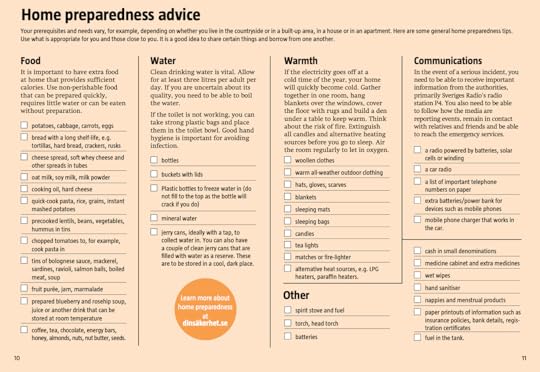
Current Swedish government advice is that citizens who can should be prepared to manage their basic needs at home for one week without support. That includes 21 litres of water per person, stored in a cool, dark place.
Here’s my list of food, medicine, and health supplies to have on hand during the pandemic. I was happy that I had planned ahead last year, and had gradually ordered extra Covid tests, masks, a pulse oximeter, and cough medicine last summer that I was able to share with friends and neighbours who needed them during the Omicron peak, when they weren’t available.
Prepare to goSince my family evacuated from the 2017 fires, and after listening to friends who have suffered the loss of their homes and all their belongings to fire, I have kept a go-bag packed and ready with essentials if I would have to leave home on short notice in a crisis. (It lives under our piano.) Here it is:
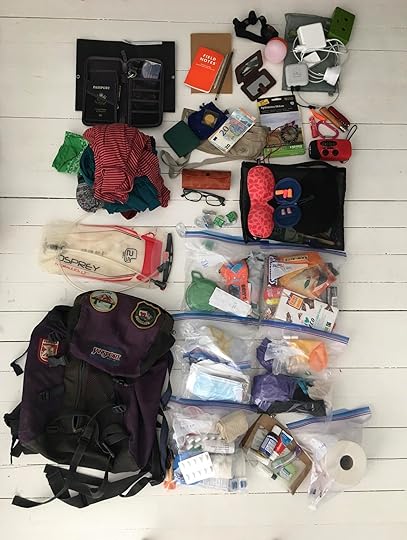 My go bag: clothing, toiletries, papers and documents, cash and jewellery, chargers and power banks, clothes, eyeglasses, water, food, masks and hand sanitiser, lady biz, first aid, toiletries & more live packed in my college backpack.
My go bag: clothing, toiletries, papers and documents, cash and jewellery, chargers and power banks, clothes, eyeglasses, water, food, masks and hand sanitiser, lady biz, first aid, toiletries & more live packed in my college backpack. There are heartbreaking (and occasionally funny) stories of what people took with them, and what they regret leaving, when evacuating from California fires. (My mom grabbed a can of her beloved, discontinued 1980s TAB soda!)
Experts recommend you have “The Six P’s” ready in case you need to evacuate:
People and pets. Obviously, the most important.
Papers (passports, birth certificates, marriage license, house deeds, legal docs) and phone numbers (written on paper - doctor, relatives, out-of-state contact, coworkers, insurance agent…)
Prescriptions (anything you need for health, including medication, eyeglasses, toiletries, menstrual supplies, basic first aid)
Pictures and personal items (irreplaceable memorabilia and photos)
Personal computers (laptop, any external storage drives)
Plastics (bank and credit cards and ID)
And hey, here’s something I looked up recently, that I hope we never need to know: what to do in case of a nuclear explosion (TLDR: get inside a building, away from windows, preferably in a basement, and stay there for 24 hours— have a supply kit there). Eeeeeek I hope I never need to poop in the bucket I put in my basement.
Prepare to help outLearn basic skills like first aid and firefighting.
Consider donating blood if you can.
Join or support a local chapter of an organisation to help out if a disaster happens in your area, like the Red Cross or Civilförsvarsförbundet in Sweden.
Volunteer with organizations in your area that are helping those in your community who need it, and/or helping welcome those fleeing disaster, like Refugees Welcome in Sweden.
To help people suffering from disasters elsewhere: send money, not stuff. Local people can decide how best to use money to get what they need. Stuff creates a huge backlog and requires resources to manage, sort, and distribute.
If you can afford it, support an organization working for disaster relief. I recently became a monthly donor to Doctors Without Borders. I decided this was a more helpful approach than haphazardly trying to research local organisations to support during specific disasters.
Parting TidbitsI was glad to contribute an interview for, and I learned a lot from reading “How the World’s Richest People are Driving Global Warming,” by Eric Roston and colleagues.
Recommended Reading: Zen and the Art of Saving the Planet, by Thich Nhat Hanh. This book almost made me cry on the first page. It is so lovely and simple and profound and centering. Highly recommend.
xo,
Kim
March 1, 2022
Climate report debrief
Hi friends,
Everything is a lot right now! Including the IPCC Climate Report published yesterday. I hope you’re doing okay. Starting right now and for the next 1.5 hours, join our live Discussion Thread for We Can Fix It subscribers by clicking the link below- I’ll be answering your questions (via text) and look forward to hearing what’s on your mind and where we go from here.
Kim



